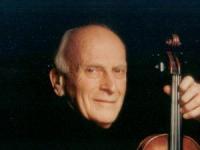| |
As the Chinese music arena and campus were open to the world, foreign experts and artists came to China successively. The mutual influence of oriental and western music exerted huge impact on the growth of Chinese musicians and the development of the Chinese music. In just more than a decade, the number of foreign artists visiting China and the breadth of their specialty were unparalleled in the history of the Chinese music. Some of them are world-class artists and representatives of artistic schools. Those artists who put on lectures in China mainly came to celebrated music academies such as CCOM and Shanghai Conservatory of Music.
Seiji Ozawa, a famous Japanese musician and permanent conductor of Boston Symphony Orchestra, was the first world-renowned musician who came to visit CCOM after the Cultural Revolution. He visited CCOM in the summer of 1978. In March 1979, Boston Symphony Orchestra led by Seiji Ozawa put on a grand concert in the Capital Indoor Stadium. During his stay, he came to CCOM again to teach and rehearse. Seiji Ozawa was surprised at the wonderful sounds of the Chinese folk musical instruments. In November 1979 Menuhin, a world famous violinist, came to China and visited CCOM for the first time and in September 1982 for the second time. He played a positive role in enhancing the reputation of Chinese violinists in the international music arena. Besides, some other music masters also visited and gave short-term lectures in CCOM, such as Stern the violinist (1979), Tortelier the cellist (1980), Paul Badura-Skoda and Fu Cong the pianists, Pavarotti, one of the top ten tenors in the world (1987), and DeLay (a famous violin instructor).
The number of foreign musicians who came to China increases year by year. Shanghai Conservatory of Music has received over 10,000 foreign visitors since 1979 from more than 20 countries, including the UK, Italy, France, Austria, Federal Republic of Germany, the Netherlands, Switzerland and Denmark. CCOM received more foreign visitors. There are foreign experts teaching different majors, such as composition, conducting, musicology, vocal music, opera, piano, violin, cello, viola, clarinet, oboe, brass, and percussion. There have been folk musicians from Japan, India, Philippines, Ghana and the U.S. who came to China to teach and perform. Kravchenko, a Soviet piano educationist who had taught in CCOM and played a positive role in the improvement of the Chinese piano art in 1950s, also came to CCOM again to give lectures in 1988.
The coming and teaching of these world-renowned performers and singers in Chinese Conservatories of Music and their demonstration performances enabled Chinese music teachers and students to see the superb performances of masters and hear their profound and unique understanding of arts, which was conducive to the growth of Chinese musicians. Some masters were given the titles of Professor Emeritus by CCOM in 1982, including Menuhin and Tortelier. Fu Cong was given the title of an Adjunct Professor.
 Yehuhi Menuhin
Yehuhi Menuhin
Besides, many well-known experts in composition and musicology came to China, such as Professor Geer from the UK, Kishibe Shigeo and Ikuma Dan from Japan, Hood from the U.S., Zhou Wenzhong, a Chinese American, Kholopov, a Soviet academician, and Yiyisan and Ake from Germany. Their visiting has brought along new information, methodology and techniques in music composition and research. There was a new and completely open atmosphere in conservatories of music.
II. The visiting of world-renowned music groups to China
Since the reform and opening-up, well-know foreign music groups have come to stage their performances in China successively. In 1979, Karajan, a world-class conductor performed works of world music masters in Beijing Cultural Palace of Nationalities, together with Berlin Philharmonic Orchestra, a first-rate orchestra in the world. The coming of Karajan was quite sensational in China then. The tickets were sold out. Music fans were intoxicated in the music and would not leave the auditorium even after the completion of the performance.
In the fall of 1986, Pavarotti, a world-renowned tenor, came to Beijing and held several sensational performances in Beijing Exhibition Center, Tian Qiao Theater, and the Great Hall of the People. The ticket of the solo concert at Beijing Exhibition Center was sold at the highest price at that time, but was still too hot to meet the demand. On the evening of the solo, people gathered at the theater entrance, waiting for tickets, which was a rare sensation in the Chinese music arena. At the end of the performance of Pavarotti, he gave six encores in a flood of applause and cheers and sang for the passionate music lovers with the most pleasant songs. “Bohemians” performed at Tian Qiao Theater also received the hottest welcome. As a result, the organizer had to hold another solo of Pavarotti in the Great Hall of the People as an exception, which was not in the original plan.
Not long after, Domingo, another world-renowned tenor, came to China and received the same welcome just like Pavarotti. In July 1988, Domingo and the Spanish Zarzuela Elite Group performed excerpts from “Zarzuela”, the most ancient and lively drama, in the Great Hall of the People. More foreign music groups have been received after the establishment of Beijing Concert Hall. In 1987, the solo concert and concerto of Yo-Yo Ma, a world-class cellist, was warmly welcomed there.
Apart from the sensations created by the above eminent artists, the visiting of some other music groups also achieved great success, such as the European Community Youth Orchestra, Philadelphia Orchestra, the U.S. Metropolitan Opera Ambassador Group, and many other ensembles, musician groups and recognized singers and performers.
|
|
